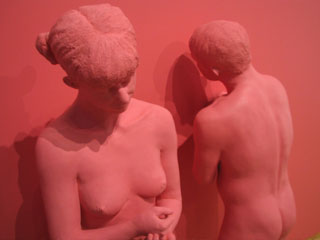Next story: Andres Garcia
Shadows & Fog
by Lucy Yau

The first thing you’ll notice about Christina West’s sculptures is that they feel a little off-kilter. Although they are sculpted realistically, their color and size will immediately put you off balance.
To begin with, the figures are done at three-quarter-scale, falling slightly below eye level, to achieve a level of intimacy and pull one down into the scene. When asked why she chose this sizing, West says, “At life-sized or slightly larger, the viewer would be required to step back. At that point, the scene becomes more of an abstraction.”
West mimics the daily encounters one has, highlighting a scene, putting the viewer in a position to act. Her clay pieces are highly detailed—a slightly paunchy, middle-aged man catatonically addressing or making a placating gesture to no one in particular, a young male plugging his ears and a girl reading by herself. West aims to draw in the viewer; it’s as if one has come across a slice of street theater and must decide what to do, how to interact, whether to participate, continue on or stand on the periphery.
To draw in the viewer further, West has chosen not to place the pieces on pedestals. She renders recognizable figures and sets up ambiguous situations. The viewer is left in a somewhat awkward state, not sure if there is an invasion of privacy. Because onlookers mix and mingle with the pieces, are they in a public setting or a private area? Their nakedness makes one uncertain. Is this a hospital setting—is the middle-aged man having a meltdown? What is the boy avoiding and trying to block out? What is the girl reading? How does the viewer fit in with the setting? There is an intrusive, almost voyeuristic aspect in viewing West’s work.
Towering over the pieces, one must stoop slightly, as though speaking to a child, in order to fully examine the pieces. West didn’t want to scale the pieces down too small, however. That would have made the figures allegorically and literally insignificant, almost cutesy.
When one rounds a corner of the gallery and comes upon one of the figures, they can have a startling effect, as though one has bumped into an errant child. How one sees her figures is a Rorschach test, more revealing of the viewer than of the work itself. Are they engaged in playful, sexual or malicious behavior? There is a tension to the pieces—they have the potential for a violent or beneficent action. One is never quite sure.
Although the figures are engaged with each other, they manifest an introspective quality, too. They inhabit a familiar universe of their own making across which we have stumbled.
Reminiscent of Ron Mueck’s figures, West’s pieces are posed in various states of undress, often completely naked in situations where one would normally be clothed. This creates a disturbing feeling: Are they aware of their nakedness? Do they care? And if not, what is behind their transgressive state of mind? If they are carefree in their lack of clothing, they are not so insouciant in their affairs with one another or with themselves. There is angst in the figures, as though they are suffering an indescribable mental malady. A sense of free-floating anxiety exists among the figures, as though they are in a fog—still, this vague unease never reaches the level of an alarming threat.
West’s colors are based on those one would find in a human body but amplified and enhanced so that they become unnatural. In previous shows, she has employed color in a distorting and subversive manner. For example, she has painted figures which had distinctly Caucasian features a chocolate brown, making them seem African. We are not to assume or assign racial identity or gender roles.
For the Shadows and Fog show at Hallwalls, West has taken a flesh-colored blush hue from her own skin, altered it and painted the walls and her figures a salmon pink. The color unifies and ties together the figures and creates a separate universe onto itself.
Other pieces in her show are two-dimensional figures with their faces cut out, reminiscent of the colorful scenes one finds at carnival photo booths. The viewer becomes a participant in her piece. Again, the scale is slightly smaller than normal and one bends slightly for a closer look at and through the composition.
West’s exhibit runs in tandem with video work by Tommy Becker, which will be reviewed here next week. There will be an opening reception for both artists on Saturday, March 1, 8-11pm. The artist will give a talk at 8pm. The show is on view until April 5, Hallwalls, 341 Delaware Avenue (854-1694/hallwalls.org).
blog comments powered by Disqus|
Issue Navigation> Issue Index > v7n9: Shadows & Fog (2/28/08) > Shadows & Fog This Week's Issue • Artvoice Daily • Artvoice TV • Events Calendar • Classifieds |









 Current Issue
Current Issue